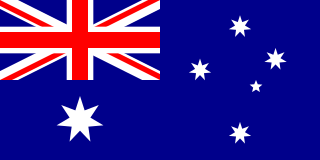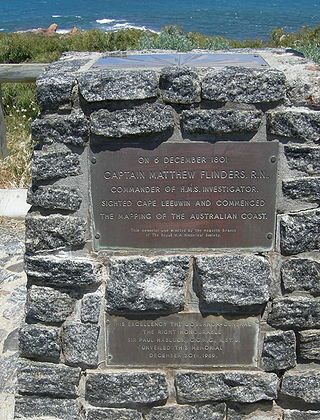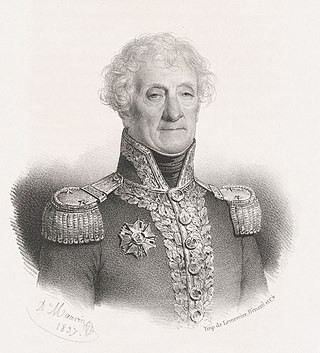Related Research Articles

The Montebello Islands, also rendered as the Monte Bello Islands, are an archipelago of around 174 small islands lying 20 km (12 mi) north of Barrow Island and 130 km (81 mi) off the Pilbara coast of north-western Australia. The islands form a marine conservation reserve of 58,331 ha administered by the Western Australian Department of Environment and Conservation. The islands were the site of three British atmospheric nuclear weapons tests in 1952 and 1956.

The Swan River Colony, also known as the Swan River Settlement, or just Swan River, was a British colony established in 1829 on the Swan River, in Western Australia. This initial settlement place on the Swan River was soon named Perth, and it became the capital city of Western Australia.

Louis Claude de Saulces de Freycinet was a French Navy officer. He circumnavigated the Earth, and in 1811 published the first map to show a full outline of the coastline of Australia.

Jean-Baptiste Louis Claude Théodore Leschenault de La Tour was a French botanist and ornithologist.
East Montalivet Island and West Montalivet Island are islands off coast of the Kimberley region, in the state of Western Australia, in the Indian Ocean. They are often referred to together as the Montlivet Islands, although this is not a gazetted name.

Cape Leeuwin is the most south-westerly mainland point of the Australian continent, in the state of Western Australia.

Flinders Bay is a bay in western Australia, immediately south of the townsite of Augusta, and close to the mouth of the Blackwood River.

Hamelin Bay is a bay and a locality on the southwest coast of Western Australia between Cape Leeuwin and Cape Naturaliste. It is named after French explorer Jacques Félix Emmanuel Hamelin, who sailed through the area in about 1801. It is south of Cape Freycinet.

Geographe Bay is in the south-west of Western Australia, around 220 kilometres (140 mi) southwest of Perth.

Rear-Admiral Jacques Félix Emmanuel Hamelin was a French Navy officer and explorer. He fought in numerous naval engagements during the French Revolutionary and Napoleonic Wars and conducted several exploratory voyages in the Indian Ocean and Southern Ocean.

Cape Naturaliste is a headland in the south western region of Western Australia at the western edge of the Geographe Bay. It is the northernmost point of the Leeuwin-Naturaliste Ridge which was named after the cape. Also the Leeuwin-Naturaliste National Park, Cape Naturaliste Lighthouse and the Cape to Cape hiking track were named after this location.

Cape Freycinet is a point on the coast between Cape Leeuwin and Cape Naturaliste in the south west of Western Australia.
The Baudin expedition of 1800 to 1803 was a French expedition to map the coast of New Holland. Nicolas Baudin was selected as leader in October 1800. The expedition started with two ships, Géographe, captained by Baudin, and Naturaliste captained by Jacques Hamelin, and was accompanied by nine zoologists and botanists, including Jean-Baptiste Leschenault de la Tour, François Péron and Charles-Alexandre Lesueur as well as the geographer Pierre Faure.

Seal Island in the Great Southern region of Western Australia is approximately 8.5 kilometres (5 mi) south-east of Albany and approximately 3 kilometres (2 mi) offshore from Frenchman Bay in King George Sound. It has a total area of 2.8 hectares. The island is designated as a nature reserve.

Géographe was a 20-gun Serpente-class corvette of the French Navy. She was named Uranie in 1797, and renamed Galatée in 1799, still on her building site. Her builder refused to launch her, as he had not been paid to that time. Finally launched in June 1800, she was renamed Géographe on 23 August 1800.

Naturaliste was one of the two-vessel Salamandre-class of galiotes à bombes of the French Navy. Under Jacques Hamelin, and together with Géographe she took part in the exploration of Australia of Nicolas Baudin.

A Voyage to Terra Australis: Undertaken for the Purpose of Completing the Discovery of that Vast Country, and Prosecuted in the Years 1801, 1802, and 1803, in His Majesty's Ship the Investigator was a sea voyage journal written by British mariner and explorer Matthew Flinders. It describes his circumnavigation of the Australian continent in the early years of the 19th century, and his imprisonment by the French on the island of Mauritius from 1804 to 1810.

Allen Island, also known as Allens Island or Allen's Island, is one of the South Wellesley Islands, in Queensland's Gulf of Carpentaria. It was named by Matthew Flinders after John Allen, a Derbyshire miner who was a member of the party of naturalists that accompanied the 1801–1803 voyage of HMS Investigator under Flinders. Flinders landed a party of botanists on the island on 20 November 1802 to search for plants.
Baudin Island is a small island in Henri Freycinet Harbour, the southern part of Shark Bay in Western Australia. The island was named after the French explorer Nicolas Baudin, who passed through the region.
Cape Hamelin is a headland 7 kilometres (4.3 mi) south of Hamelin Bay in the Capes region of south-western Western Australia. Except for Cape Leeuwin, it is the southernmost of over 1,000 kilometres (620 mi) of features named by the French in their travels along the coast.
References
- ↑ "Peter Monteath". Flinders University. n.d. Retrieved 14 June 2017.
- ↑ "Peter Monteath on Trove Books". National Library of Australia. Retrieved 15 June 2017.
- ↑ "Frank Broeze Memorial Maritime History Book Prize". Australian National Maritime Museum. Retrieved 14 June 2017.
- ↑ "2016 Prime Minister's Literary Awards Shortlist". Ministers for the Department of Communications and the Arts. Retrieved 15 June 2017.